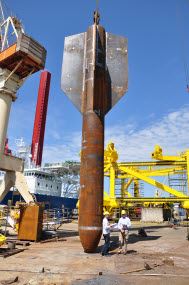
|
|
Each anchor starts its descent under cable control, but for the final 75 m it drops in free fall until it reaches a speed of 100 kph. |
In the 90s, when petroleum production began moving towards deeper waters, Lieng was a geotechnologist with SINTEF. He envisaged a better solution than the box-like suction anchors of the time that were placed on the seabed.
These are open at the bottom and function by pumping out the water inside, thus creating a vacuum that pulls the anchor into the substrate so that it holds solid.
However, the need to carefully orient such anchors, and their sensitivity to high seas and waves, makes for problems when they are being deployed, in many cases involving delays that can cost millions a day.
Jon Tore Lieng thought that the simplest concept would be to drop a sufficiently heavy anchor straight down into the sea. If it was heavy enough, and moving fast enough, such an anchor would force its way into the seabed and create and extra powerful hold.
Free-fall drop
Two of the new anchors have already been installed on StatoilHydro’s Gjøa field near the Troll field. The anchors, which were manufactured in Lithuania and have been approved by Veritas, penetrate 31 and 42 metres respectively into the seabed.
The new anchors are not affected by waves, and the installation process is the same whether they are being deployed at depths of 500 or 3000 metres. Each anchor starts its descent under cable control, but for the final 75 m it drops in free fall until it reaches a speed of 100 kph.
A remotely operated vehicle (ROV) follows the manoeuvre and transmits the acoustic signal that releases the anchor for the final stage of the descent. Then ROV then goes down to check the situation on the seabed, and the chain is tightened up.
A typical mooring configuration for a platform will consist of 12 – 16 anchors located in three or four groups. All the anchors can be carried by a single auxiliary vessel and deployed in the course of a single trip to the field.
Studies and tests
The path to today’s full-scale trials has been long. At the same time as the offshore industry was beginning to move to deeper waters in the 80s, the Research Council of Norway launched its deepwater and offshore programmes, which were looking for proposals for new mooring technologies.
At that time, Lieng carried out a theoretical study, which he sent to all the oil companies that were based in Norway. His unusual concept was turned down, but at least the companies became aware that he was working in this area.
In 1997, Lieng took his idea with him when he left SINTEF and set up his own company GeoProbing Technology, with a licence for the patent. After a while, he made contact with people in Statoil who liked his ideas, and in 1998 and 1999 the company financed feasibility studies and model tests. The idea was to find out how large the anchor needed to be, and how much it would cost.
The scientists soon worked out that the new anchor concept would cost about 35 percent less than the technology then in use. Since we are talking here of hundreds of millions of kroner, this meant a significant saving.
In spring 2003, Lieng and the Statoil scientists moved into the Trondheimsfjord to test a 4-metre scaled-down version of the anchor. But the fibre cable attached to the anchor broke near the seabed when they were testing its holding power, and the anchor was lost.
“As well as the anchor itself, all the instrumentation was installed in its tail-end,” says Lieng. “That was a bad day.”
The anchor lay on the seabed for three years before it was found again and another company took on the job of bringing it to the surface. Meanwhile, the project was abandoned, and Jon Lieng worked as a consultant in offshore marine geotechnology.
Full-scale trials
After that low point, however, things began to move again. StatoilHydro is currently evaluating a number of development projects off the coast of Norway that involve depths of around 1000 metres, as well as 30 or so deepwater fields in the Gulf of Mexico, all of them more than 2000 metres deep. These have brought the problem of cost-effective mooring back into the spotlight.
The Gjøa field is the first full-scale trial being run by StatoilHydro, and the concept is gradually gaining acceptance.
Jon Lieng himself is in the national and international marketing phase, visiting field development operators, oil companies and offshore companies that supply mooring systems.
“I am counting on making us known as one of several possibilities, and I believe that we can make our mark in the competition to supply mooring system, in terms of both price and robustness,” says this quiet-spoken entrepreneur.
